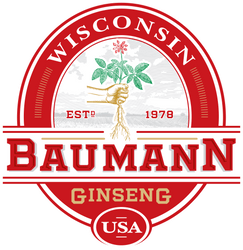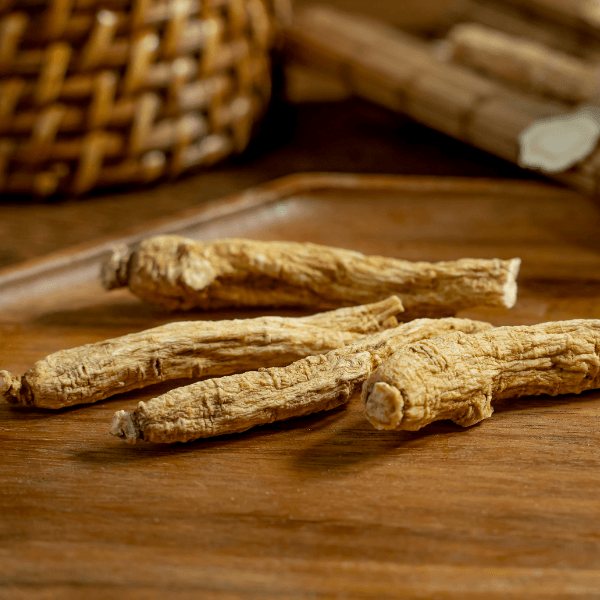
Ginseng, used for thousands of years around the world for its health-boosting and therapeutic effects, is a hugely popular supplement and ingredient. But, while you may have heard the name thrown around before, it’s easy for it to get lost in a long list of other natural ingredients and to miss its uniquely rejuvenating properties, and you may find yourself asking: what is ginseng, and where do I begin with it?
In this post, we’ll talk you through what ginseng is, the main types of ginseng, what it can be used for, and how to start incorporating ginseng into your daily routine.
What is Ginseng?
Ginseng is a herb consisting of a leafy top, a long stalk, and a fork-shaped root similar in appearance to a parsnip or ginger. The main two strains, American ginseng (Panax quinquefolius) and Asian ginseng (Panax ginseng) are the two types most commonly used by people around the world today, and it’s the root of the plant that contains its active ingredients that boost health and wellness in lots of different ways.
What is Ginseng Used For?
Ginseng has been used since ancient times to fight against all kinds of ailments and help maintain good health and a strong immune system. Traditionally used in Chinese medicine and, with American ginseng, by Native Americans for its medicinal effects, ginseng today is hugely popular all over the globe for use as a therapeutic, in medicine, and as a health supplement. The use of ginseng has been shown to help with, amongst other things, maintaining blood sugar, increasing energy levels, sharpening mental function, and fighting against and preventing respiratory tract illnesses.
What Are The Main Types of Ginseng?
If you’ve ever bought ginseng before, or seen it in stores, chances are it was one of two species: Asian ginseng and American ginseng are the most common kinds and are produced and sold widely. For the latter, American Wisconsin ginseng is the gold standard for its healthy effects and concentration of miracle active ingredients. Of the types available though, there are a few distinct kinds, all with their own qualities and strengths.
1. Asian or Korean Ginseng – Panax Ginseng
Also known as red ginseng, Asian or Korean ginseng has been used in traditional Chinese medicine for millennia. Its vitalizing qualities have carried over into the modern world and now it’s one of the most popular types of ginseng used around the world.
Asian ginseng contains a high concentration of ginsenosides, which are the active ingredients that give ginseng its unique boosting qualities. The Asian strand of ginseng is hugely valued for a wide range of health benefits and has been used and celebrated for various uses including, among other things, increasing physical stamina, boosting immune cells, improving cognitive ability and mental concentration, and erectile dysfunction. Asian ginseng can sometimes be darker in appearance than other types but looks similar to American ginseng.
2. American Ginseng – Panax Quinquefolius

Like its Asian counterpart, American ginseng is a highly popular species of the herb; cultivated in North America, it’s valued and used by people everywhere. Similarly to Asian ginseng, the ginsenosides in the American species give it its transformative health-giving effects; American ginseng, however, is usually said to have more of a calming, relaxing effect, and is used widely for its many benefits, including regulating blood sugar, relaxation and reducing stress, and to help prevent and fight various cancers.
For ginseng grown in the United States, American Wisconsin ginseng is the choice most valued by consumers, due to the highly fertile soil in the region, containing the ideal balance of nutrients, minerals, and moisture. If you’re thinking about trying out this incredible herb, ginseng Wisconsin is the way to go.
3. Indian Ginseng
Less common than the former two species for popular consumption, Indian ginseng is used primarily in traditional Ayurvedic medicine. Also known as Ashwagandha, it’s praised for its antioxidant effects and a range of other health benefits.
However, while Indian ginseng is often used in the same sentence as Asian and American ginseng, it doesn’t contain the same active ginsenosides that give the two widely-used types their unique properties and so isn’t considered a true ginseng.
4. Siberian Ginseng
Similar to Indian ginseng, Siberian ginseng isn’t considered a pure version of the herb: while it’s a distant cousin to the Asian and American species, it doesn’t contain the same active ingredients.
What it does have, though, is different chemicals in it – called eleutherosides – which means that it can also super-charge your health in different ways! This woody-looking root has been celebrated for its ability to strengthen the immune system, boost energy levels, reduce the length of colds – and even display anti-tumor properties.
5. Brazilian Ginseng
The final type in our list, Brazilian ginseng is – you guessed it! – also a herb which, although called ginseng, doesn’t contain the ginsenosides that make the American and Asian types so fruitful. Also known as suma, this dried vine root was nicknamed Brazilian ginseng once ginseng’s popularity skyrocketed.
While it doesn’t have the same ingredients, Brazilian ginseng can have similar effects to the other types shown here and is used to help combat fatigue, and as an aphrodisiac.
What Makes Asian And American Ginseng Better
While all of the types listed here can have great effects on your health, only Asian and American ginseng contain the vital ingredients that give the herb its wondrous effects: ginsenosides. It’s the ginsenosides within the ginseng root that make Asian and American ginseng so valuable to the best functioning of our bodies, and why they are so prized and used by so many people regularly.
For American ginseng, it’s ginseng Wisconsin that has the perfect balance of ginsenosides to make it a herb that can truly change your life.
Is Ginseng Safe to Use?
Of course! Used at a normal level, ginseng is perfectly safe and easy to take or to incorporate into food. Due to its stimulating qualities, consuming large amounts of ginseng can lead to some caffeine-like effects, so if you have a sensitivity to this, considering lowering your intake. It’s also advisable to check with your doctor if you’re taking any other medications, as it can interact with some drugs used for diabetes and depression.
Generally speaking though, when bought from a well-respected provider, ginseng is totally safe and is an incredible addition to your nutrition routine.
How to Use Ginseng?
Ginseng’s a hugely versatile herb, and it can be used in several different ways. While it’s often taken as a supplement with the root powdered in a pill form, it’s also delicious and calming as a tea. There are also loads of great recipes that have ginseng as an ingredient, meaning that if you’re a pro in the kitchen, you can grab yourself some ginseng root and enjoy its unique flavors while also reaping the rewards of its health benefits!
If you think it’s time to start feeling the benefits of ginseng, Baumann American Wisconsin Ginseng is a source you can trust. Founded in 1978, we’ve cultivated our ginseng with care and skill for decades in fertile Wisconsin soil, giving you ginseng of premium quality.

